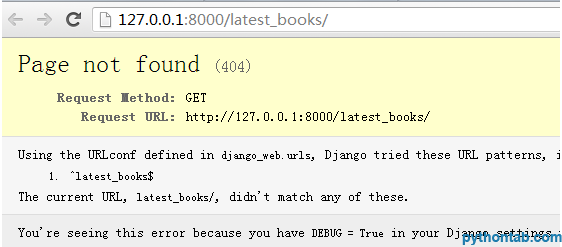django中'url映射規則”和'服務端響應順序”
- 高洛峰原創
- 2016-10-17 13:55:251248瀏覽
1、django搜尋路徑
使用 import 語句時,Python 所尋找的系統目錄清單。
查看方式:
import sys
print sys.Lango
print sys.好。 2、url配對模式 基本結構: '^需要配對的url字串$' PS:實際上所符合的url字串$' PS:實際上所符合的url字串是http://根路徑連接埠/url字串 系統自動新增的部分'http://根路徑:連接埠號/' eg:url符合模式:'^latest_books/$' .0.1:8000/latest_books/' 1)^:符合「子串頭」。 eg: '^latest_books/' 'http://127.0.0.1:8000/latest_books/',.
' http://127.0.0.1:8000/latest_books/test2/', 'http://127.0.0.1:8000/latest_books/test1/aaa/' st_books/test1/aaa/' 2)$:以「子串結尾」配對。 eg: 'latest_books/$' 'http://127.0.0.1:8000/latest_books/',. s/',
' http://127.0.0.1:8000/updir_2/latest_books/'
都會被配對。
3)子字串結尾是否包含'/'
預設必須加入(django開發者的基本習慣),如果不加入將會出現以下情況:
from django.conf.urls import patterns include
(urlpatterns = patterns('',(r'^latest_books$', 'django_web_app.views.latest_books'),) .py中新增設定:APPEND_SLASH=False 但是必須安裝了CommonMiddleware才會運作。
但是必須安裝了CommonMiddleware才會運作。
4)手動設定網站「根目錄」
在不手動設定網站「根目錄」對應「視圖函數」的情況下,會出現以下情況:
根目錄函數」: a)urls.py
a)urls.py
from django.conf.urls import patterns, url, include
urlterns = patter1, (r'^$','django_web_app.views.home_page') ,
(r'^latest_books/$', 'django_web_app.views.latest_books'), _page(request):
return render_to_response('home_page.html')
c)home_page.html
This is home page, welcome !
運行結果:
3、服務端回應url請求的執行順序🎀
1) __init__.pysettings.py『 .py
wsgi.pydjango_web_app
》 〜 〜 〜 〜 〜 〜 〜 〜 〝〝〟〟〦〟〦〟〦〦〦〦 admin.py
models.py testtesttesttesthtest. templates
templates
home_page.html
『 㟎
〜 、〜 〜〜書. manage.py 2)執行順序 a)啟動服務端-python manage.py映射關係檔案路徑:ROOT_URLCONF = ' django_web.urls' 頁面檔案範本路徑:頁面檔案範本路徑:
頁面檔案範本路徑:頁面檔案範本路徑:
頁面檔案範本路徑:TEMPLATE_DIRS = ( os.path.join(BASE_DIR, os.path.join(BASE_DIR, '資料庫設定:
DATABASES = {
'default': {
ango_db',
'USER': 'root ',
'PASSWORD': 'feng',
'HOST': '127.0.0.1',
} 含
b)回應順序
第一步:瀏覽器提交請求
http://127.0.0.1:8000/latest_books/
第二步:服務端根據請求的url在urls.py中進行匹配,並找到對應的“視圖函數”第三步:呼叫對應的「視圖函數」 傳回一個HttpResponse物件
第四步:django轉換HttpResponse物件為適合的HTTP response,並傳回頁面顯示

